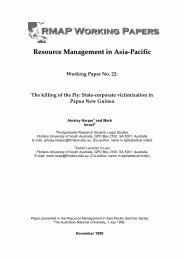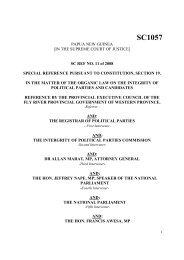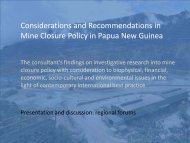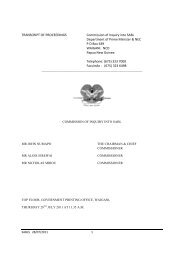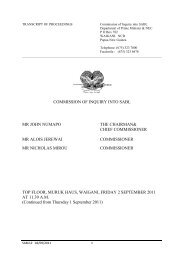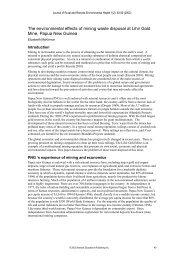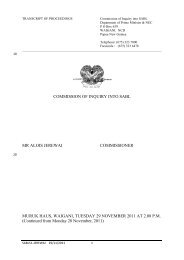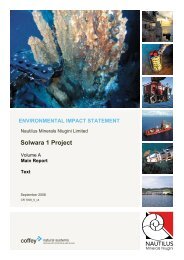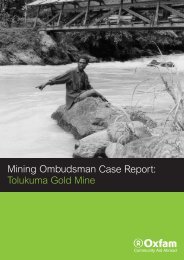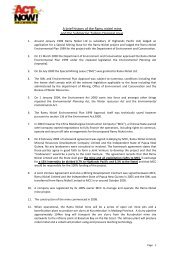Fishy business. The Social Impact of SST.pdf - Act Now!
Fishy business. The Social Impact of SST.pdf - Act Now!
Fishy business. The Social Impact of SST.pdf - Act Now!
You also want an ePaper? Increase the reach of your titles
YUMPU automatically turns print PDFs into web optimized ePapers that Google loves.
<strong>The</strong> adverse non-immune (toxic) and immune (allergic) reactions to seafood are the result <strong>of</strong>exposure to the seafood itself (muscle and connective tissue, exoskeleton, blood, endolymph fishjuice, skin, skin slime/mucin, entrails) or to various non-seafood components present in theproduct.Aerosolisation <strong>of</strong> the seafood during processing has been identified as a potential high riskactivity for immunological sensitisation by high molecular weight proteins, respiratorysymptoms, non-specific bronchial hyperresponsiveness, and work related asthma. Processesinclude degutting, heading, and cooking/boiling <strong>of</strong> fish, mincing <strong>of</strong> seafood, fishmealmilling/bagging, and cleaning <strong>of</strong> the processing line and storage tanks with high pressuredwater. Despite high levels <strong>of</strong> automation in larger workplaces, workers may still be at high risk<strong>of</strong> developing health problems due to inadequate and poorly designed local exhaust ventilationsystems. <strong>The</strong>re is great variability <strong>of</strong> exposure to bioaerosols with allergen concentrationsranging from 2 ng/m 3 in a fish market to 1000 ng/m 3 in a salmon processing plant. Wetprocessing activities (grading, gutting, packing fish, automated gutting machine) in salmonfilleting plants appear to produce higher particulate (respirable fraction) concentrations than dryactivities (fish butchery, packing in cold store and box store). Consistently high mean fishantigen concentrations (thoracic fraction) have been detected in fishmeal loading and baggingactivities (>100 ng/m 3 ) compared to fish canning activities in South African workplacesprocessing anchovy and pilchard fish respectively. Fishmeal operations also producedconsistently increased levels <strong>of</strong> endotoxin (>50 endotoxin units (EU)/m 3 or ~5 ng/m 3 ). While nothreshold limit values currently exist for exposure to fish or other seafoodallergens, a level <strong>of</strong> 50EU/m 3 has been proposed for endotoxin related health effects.Occupational dermal exposure occurs mainly as a result <strong>of</strong> unprotected handling <strong>of</strong> various fishand their products at various stages in the production process. Fish juice contains high molecularweight proteins, biogenic amines, histamine and cadaverine, degradation compounds in old fish,and digestive enzymes (pepsin and trypsin). <strong>The</strong> major skin manifestations associated withexposure are contact urticaria and eczematous contact dermatitis <strong>of</strong> various types. Contact withthe proteinacious fish material causes a chronic recurrent dermatitis commonly known as proteincontact dermatitis (PCD). At least 75% <strong>of</strong> eczematous dermatitis cases are however <strong>of</strong> an irritantnature due to contact with water and products in fish juice. Other chemical agents (handcleaners, soaps, detergents) used by workers also cause an irritant contact dermatitis.Biochemical sensitisers (for example, garlic, onion, spices, mustard) added to seafood produce adelayed allergic contact dermatitis.Measures to protect workersPrimary preventive measures are key to minimising exposure to workplace hazards that result inoccupational injuries or diseases. <strong>The</strong>se include surveillance <strong>of</strong> exposures, injuries, anddiseases; analysis <strong>of</strong> surveillance data to assess risk and identify trends; control <strong>of</strong> workplacehazards through engineering controls, personal protective equipment, and administrativeprocedures; and education and training programmes for workers to ensure adequate precautions.<strong>The</strong> control <strong>of</strong> exposure to physical hazards such as excessive noise and cold temperature isstandard to any type <strong>of</strong> industry. Primary preventive measures for excessive noise exposureamong cannery and fishmeal operators require the institution <strong>of</strong> hearing conservationprogrammes. <strong>The</strong>se encompass engineering controls such as enclosure <strong>of</strong> the source to reducelevels below 85dBA; demarcation <strong>of</strong> noise zones and sign posting; wearing <strong>of</strong> hearing protective201



